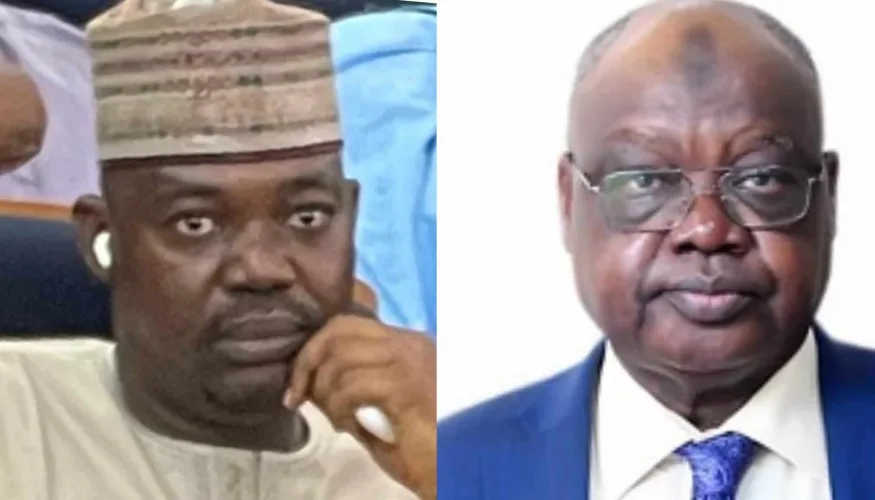HOW SUPREME COURT JUSTICE DATTIJO’S SON WAS KILLED
- SUPREME COURT JUSTICES VISIT DATTIJO
More details have emerged on the gruesome killing of Aliyu Musa Dattijo, the son of former Supreme Court jurist, Justice Musa Dattijo Muhammad.
CITY LAWYER gathered that while there are strong indications that Aliyu was attacked with dangerous weapons, the assailants may have ran over him with a vehicle.
Born on 8th February 1980, Aliyu studied Estate Management at the Federal University of Technology (FUT Minna) and graduated in 2008.
Meanwhile, CITY LAWYER gathered that a delegation of justices of the Supreme Court visited the grieving and outspoken jurist whose valedictory speech during his retirement from the apex court opened a can of worms.
There are strong indications that the killing of Aliyu shook Dattijo to his foundations, even as he has petitioned the Department of State Services to fish out the killers of his son.
A part of Dattijo’s letter which was received by the DSS on 4th September, 2004 reads: “I am writing to report the tragic death of my son, Aliyu Musa Dattijo, aged 44, which occurred on the 20th of August, 2024, between 8:30 pm and 9:30 pm, at the Sani Abacha Express Way, by Wuse under bridge Utako, Abuja. Aliyu… was said to have left home around 7:30 pm to meet with an unidentified person for business…
“The preliminary police report states that Aliyu was a victim of ‘a hit and run fatal motor/pedestrian accident’ which resulted to his death at the spot of the incident. His car (Peugeot 406 with registration number ABC 40 AW) was found by the aforesaid highway, under the Wuse Market pedestrian bridge, with the door open and keys nowhere to be found…The intervention of your office (SSS) is humbly sought to aid with the investigation…”
According to a family source, “I got to the station at around 12:30, and at that time, we hadn’t even seen the body because they didn’t allow us to see it. Eventually, some male members of the family stayed behind while the females were asked to home. Subsequently, he was released to them and then they proceeded to take the body to the central mosque so that they would help to prepare the body. It was at the mosque they now saw the state in which the body was in.
“They Noticed a lot of gashes; stab wounds on his hands, like somebody had tried to cut him with an axe or something. Offensive wounds. They noticed that there was a stab wound on his stomach, which led to his gut spilling out. And then his legs looked like they were crushed under a vehicle. And then obviously his skull too was, you know, cracked and all of that. So having seen the way the body was, they asked the police officers to take them where the incident happened; which they did.
Described by the immediate past Chief Justice of Nigeria, Justice Olukayode Ariwoola as “outspoken,” Dattijo had queried the enormous powers of the Chief Justice of Nigeria, indicating that a reform has become urgent.
Muhammad asserted that the CJN, given his enormous powers, appoints members of the various judicial institutions without conferring “with fellow justices nor seek their counsel or input on any matter related to these bodies. He has both the final and the only say.”
“The CJN has the power to appoint 80 per cent of members of the council (NJC) and 60 per cent of members of FJSC. The same applies to NJI and LPPC.
“Such enormous powers are effortlessly abused. This needs to change. Continued denial of the existence of this threatening anomaly weakens effective judicial oversight in the country,” Muhammad noted.
Speaking on the composition of the court’s seven-member panel which dismissed the appeals filed by Atiku Abubakar and Peter Obi against the election of President Tinubu, Mr Muhammad said all the six geopolitical zones in the country ought to be represented.
Of the six regions in the country, only South-south, North-west and the North-east were represented on the panel of six members.
Dattijo had sensationally blamed the tardiness in ensuring the two regions had representatives on the Supreme Court bench on the CJN. He said it was deliberate and it “is all about the absolute powers vested in the office of the CJN”.
It was unclear at press time whether the secret police has commenced investigation into the matter.
To join our CITY LAWYER Channel on WhatsApp, click here
To join our Telegram platform, click here
COPYRIGHT 2022 CITY LAWYER. Please send emails to citylawyermag@gmail.com. Join us on Facebook at https://web.facebook.com/City-Lawyer-Magazine-434937936684320 and on “X” (TWITTER) at https://twitter.com/CityLawyerMag. To ADVERTISE in CITY LAWYER or for Special Features, please email citylawyermag@gmail.com or call 08138380083.
All materials available on this Website are protected by copyright, trade mark and other proprietary and intellectual property laws. You may not use any of our intellectual property rights without our express written consent or attribution to www.citylawyermag.com. However, you are permitted to print or save to your individual PC, tablet or storage extracts from this Website for your own personal non-commercial use.
